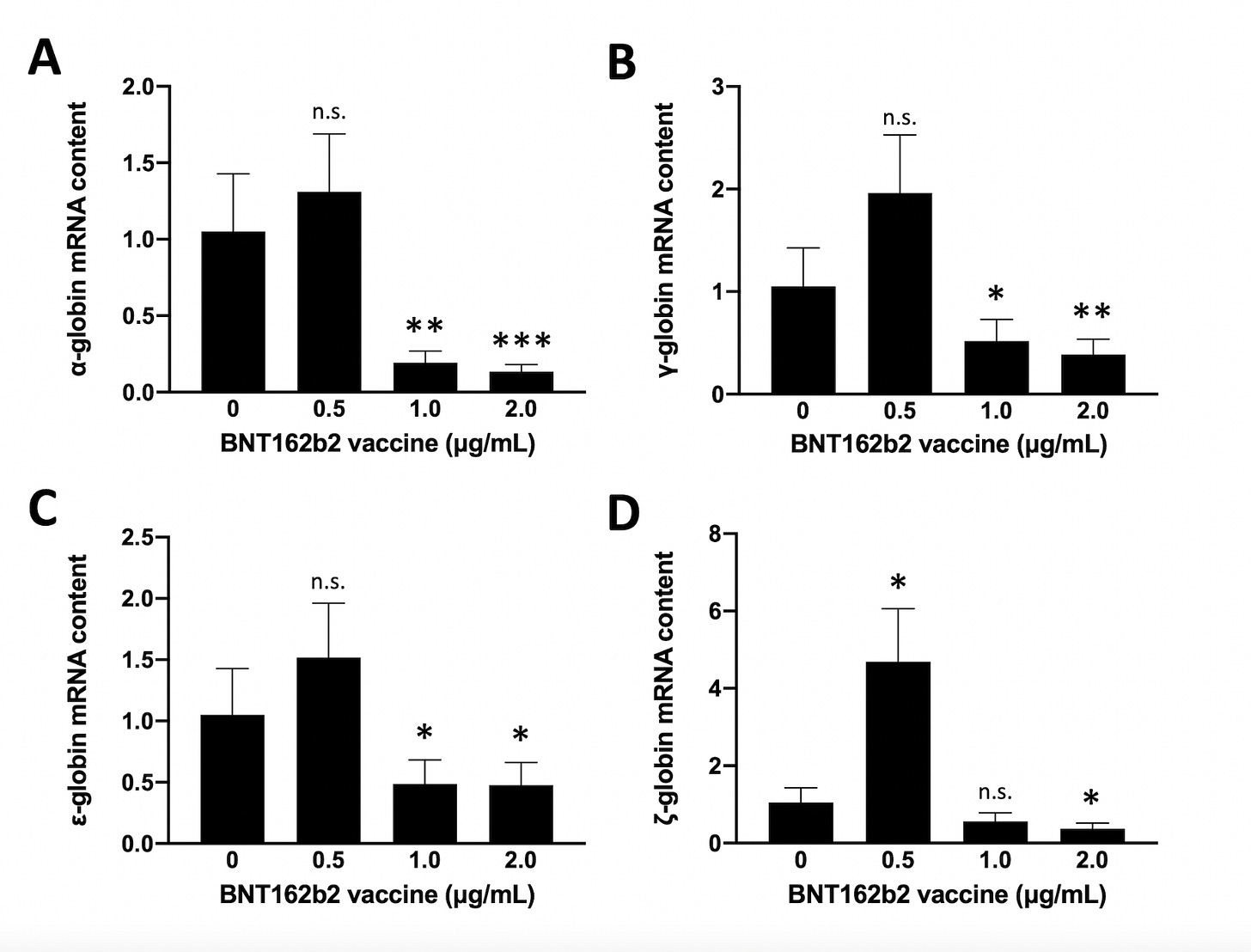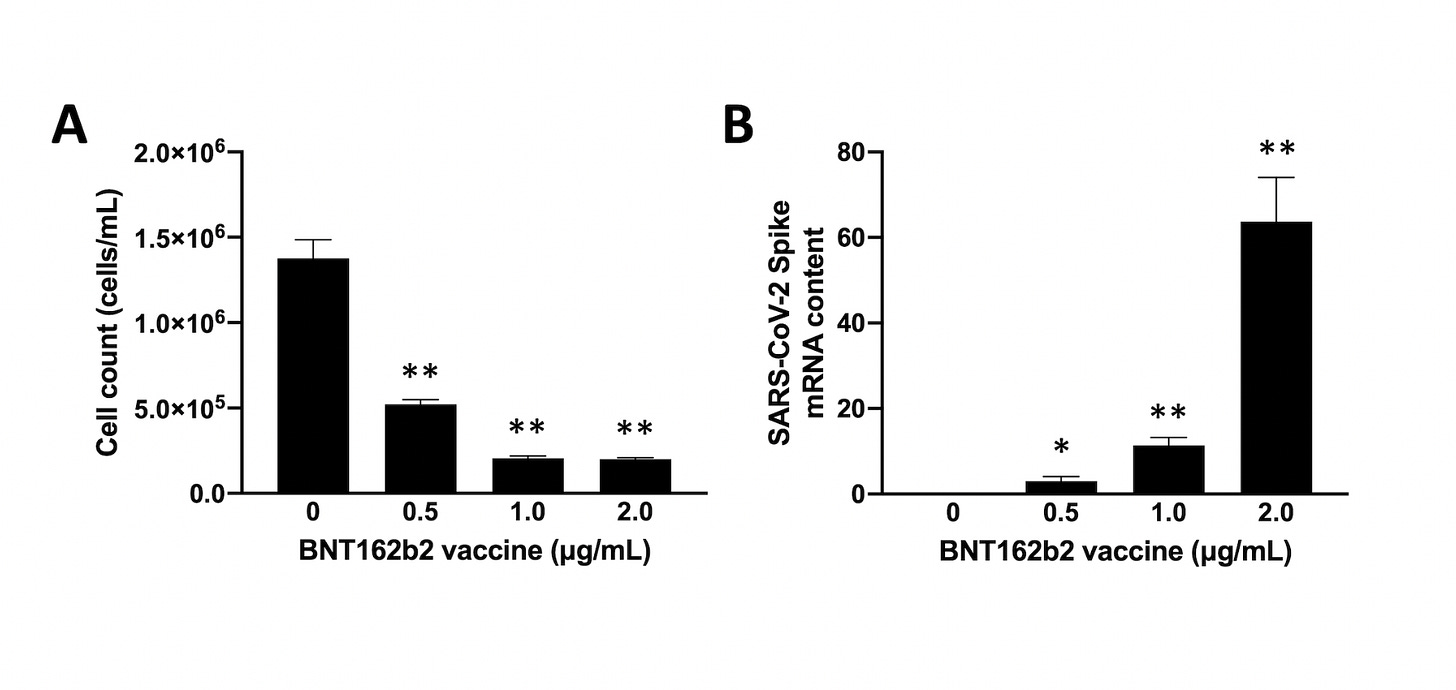Pfizer-BioNTech COVID-19 vaccine sharply inhibits accumulation of embryo-fetal globin mRNAs
A new pre-print study: 'The anti-SARS-CoV-2 BNT162b2 [Pfizer-BioNTech COVID-19] vaccine suppresses mithramycin-induced erythroid differentiation and expression of embryo-fetal globin genes in human erythroleukemia K562 cells' was published on September 7 by a team of Italian scientists from the University of Ferrara.
The researchers of the Zurlo et al. study treated human K562 cell lines in vitro with increasing concentrations of the Pfizer-BioNTech COVID-19 mRNA (BNT162b) vaccine to study the effects.
They found that increased concentrations of the BNT162b2 vaccine sharply inhibits the expression of embryo-fetal globin genes in K562 cells.
“The BNT162b2 vaccine suppresses mithramycin-induced erythroid differentiation of K562 cells. Reverse-transcription-PCR and Western blotting assays demonstrated that suppression of erythroid differentiation was associated with sharp inhibition of the expression of α-globin and γ-globin mRNA accumulation. Inhibition of accumulation of ζ-globin and ε-globin mRNAs was also observed.”
Source: Zurlo et al. study published on preprint server bioRxiv
The results are alarming-given the major implications that a drastic inhibition on the accumulation of fetal globins could have on a baby’s development in utero, if the baby is exposed to the mRNA COVID-19 vaccine via their vaccinated mother.
Several of my investigative reports for Children’s Health Defense Europe and Trial Site News shined a spotlight on the devastating adverse events on fetuses exposed to the Pfizer-BioNTech mRNA vaccine via the placenta. My reports are based on the data found in Pfizer’s own pharmacovigilance reports for the EU’s European Medicines Agency and the US Food and Drug Administration.
Fetal hemoglobin (Hb F) is a principal oxygen carrier in both preterm and term neonates. A tetramer of two alpha- and two gamma-globin chains make up the fetal hemoglobin molecule. Around birth, expression of gamma-globin is progressively silenced and beta-globin expression is activated. Fetal hemoglobin has a significantly higher affinity for oxygen than adult hemoglobin.
Human K562 cells are bone marrow stem cells isolated from a 53-year-old chronic myelogenous leukemia patient. The K562 cell line is widely used in immunology and immune system disorder research.
The researchers chose to use the human K562 cell line for the following reasons:
It is studied as a model system mimicking some steps of erythropoiesis. (Erythropoiesis is the human body’s process of making red blood cells.)
They express baseline levels of globin genes, the most important being those coding the embryo-fetal a-, z-, e- and g-globins.
Fetal hemoglobin (Hb F) are also produced by K562 cells.
K562 cells have been used as a model system to study the regulation
of the expression of embryo-fetal globin genes.
The researchers found that as the concentration of the vaccine was increased, proliferation of bone marrow stem cells was significantly inhibited. (Figure A)
Source: Zurlo et al. September 2023 study
The Italian team also found that as (BNT 162b2) vaccine concentration was increased- the level of spike protein dramatically increased. (Figure B)
Spike protein is known to increase expression of pro-inflammatory genes through up-regulation of NF-kB and is a cause of many major side effects of the COVID-19 mRNA vaccines, where according to Trougakos et al.:
“Binding of circulating S protein to angiotensin-converting enzyme 2 (ACE2) or to other targets, along with the possibility of molecular mimicry with human proteins, may contribute to the vaccination-related adverse events (AEs).”
Ropa et al. showed that hematopoietic stem cells from human umbilical cord blood express ACE2 (which the spike protein binds to) and were adversely affected by spike protein in terms of their ability to proliferate and expand into progenitor cells.
The hematopoietic system is responsible for giving rise to the very immune cells that defend against viral infection.
The researchers from the Zurlo et al. study went on to conclude:
“The major conclusion of our study is that the BNT162b2 vaccine efficiently transfers the SARS-CoV-2 S-protein mRNA to K562 cells, causing, as expected, production of the S-protein. This was found to be associated with suppression of erythroid differentiation and, more importantly, with sharp inhibition of endogenous and mithramycin induced expression of embryo-fetal globin genes.”
The researchers noted that the results of their study are of interest, particularly when considering other recently published reports, such as Ropa et al. (referenced earlier) and Estep et al., where scientists found that “SARS-CoV-2 infection and COVID-19 vaccination dramatically impair the functionalities and survivability of hematopoietic stem progenitor cells (HSPCs) in the umbilical cord blood.”
This study, published more than two years after health authorities first began their relentless push to get the COVID-19 mRNA shot into the arms of all pregnant women, further demonstrates how this experimental product was never properly investigated. This vulnerable subpopulation was not even included in Pfizer’s clinical trial.
Furthermore my report for Trial Site News, co-written with Daniel O’ Connor documented how the Biden administration paid over $6bn to health centres to encourage vaccine uptake. Scandalously, part of that money was funnelled to the American College of Obstetricians and Gynecologists (ACOG) to push the vaccine onto pregnant woman.
To this day, the FDA’s EUA document states: “There are currently insufficient data to make conclusions about the safety of the vaccine in subpopulations such as children less than 16 years of age, pregnant and lactating individuals, and immunocompromised individuals.”
I’d like to thank Prof Retsef Levi for bringing this paper to my attention.
If you believe the work I’m doing is important, consider becoming a paid subscriber or upgrade to one and help support independent investigative journalism! You can also buy me a coffee!






Sounds like the neonates are getting less O2
Am trying to interpret this. Is implying neonates, born to jabbed mother's, emerge likely with measurably deficient immune systems?